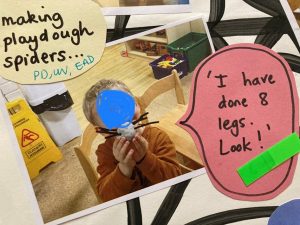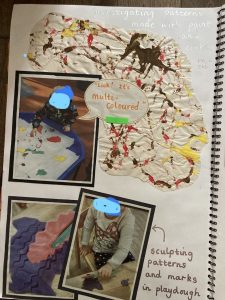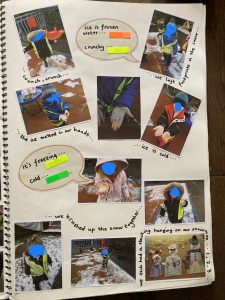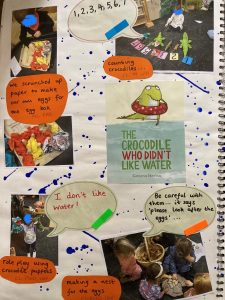So, why use floor books in early years and how do they work alongside the Early Years Foundation Stage curriculum? Early years teacher, Katherine Bate, reveals there are many answers to that question…
The main reason has to be of benefit to those little lives we touch every day. Why else would we tolerate being regularly sprayed with water, paint (or worse!) if it wasn’t for those teeny-tiny reasons who meet us every day on the door, smiling to come into our setting? Children love to look at pictures of themselves and talk about work they have done. I have found that a floor book is an ideal stage from which to showcase their work and is more easily accessible than a high display board. Looking back through a floor book with a child is also a really good tool to encourage those prime areas of development: Communication & Language, Personal, Social and Emotional Development and Physical Development. But looking at a big book or floor book is more than just an academic exercise. It is about building a sense of pride in what we have done together, demonstrating to the children that their work is valued and giving the child an opportunity to find their voice. What could be better than that?
I know things have been a little different in terms of inviting parents/carers into our settings during lockdown. I have been amazed at how well our little souls have coped with change and with leaving their adults at the door (and also, at how well the adults have coped with having to leave their children at the door too!) so a floor book is a super way for us to share our learning with other significant adults in our children’s lives (see top tips below!) Senior leaders / management teams also love to see progress, and this is a great way to provide that evidence.

There is nothing more satisfying than to scroll through the pages of a floor book, crammed full of the child’s voice and evidence of their learning. Using a book in this way is a natural process – but beware of the trap of duplicating children’s work (see top tips below!) It is also a good idea to think about marking on the pages how each topic / photo links to your curriculum, thus helping with assessment and ensuring a broad, balanced, and ambitious curriculum.
You can use the floor book to record all aspects of the children’s learning, from World Book Day to simply investigating eggs! I also transfer children’s work straight from our working walls and into the floor book, which is a great way to keep momentum of learning and show progression. The book also gets full pretty quickly too! Perusing our floor book takes you on a journey through the complete life of our school nursery. You will see all sorts of things: we even documented when a huge truck came and delivered stones via a mechanical arm to our outdoor area. Taking photographs and sticking them into the book with the children sparked conversation from even our more reluctant talkers – what better reason to use floor books do you need than that?
It may be that you still feel floor books aren’t for you. But if you would like to give them a go, here are a few top tips to get you started:
This might sound obvious, but it is very easy to get carried away sticking and gluing whilst watching your favourite box set! Remember what you are trying to say and focus on ways to say it.

This could be in the way of speech bubbles next to photographs, sticky notes added afterwards or just typed or handwritten direct quotes. Whilst in reception, I used to show the book to groups of children and ask them to write their comments on yellow stickies and add them to the book themselves!

Every floor book will look unique as it is reflecting different practice and representing different children. Feel free to Pinterest ideas but ultimately, make it your own. Use colours, scrapbooking techniques, magazine photos, typed fonts or handwritten notes – it’s up to you!

I have lost count of the number of times I have used pages from the big book/floor book to back up my judgements within early years. Make sure each page shows evidence of individual children’s comments / writing / mark making if you want to do this, as a page showing every child’s identical rainbow fish isn’t going to give you the individual evidence you need. However, a page showing each child’s independent effort, spoken comments / photographs, probably will.

What is the point of spending hours on a beautiful book, if no one ever sees it? Get it out there! Let parents/carers have a flick through at drop off / pick up times, take photos of the pages and publish on social media, newsletters, make the book into a pdf and email out to stakeholders, etc. Make sure you always seek parental permission when using in this way.

There is no better time to celebrate our amazing children and showcase what they have done. As one parent who emailed me recently said,
‘Looking at the work just shows how much he has done this year (even if every single day since September, all he has told me is that he has had a pear for snack and played with the dinosaurs!) Keep doing the good work that you do!’
I love that last comment, don’t you?
Let’s keep doing the good work that we all do and let’s showcase it to the world. After all, our children deserve to be celebrated!
If you missed Tamsin Grimmer and Katherine Bate’s webinar on floorbooks you can access the recording by subscribing to Kinderly Learn:

Katherine Bate trained as a primary school teacher and after many years in reception class, is currently working as an EYFS nursery teacher. Katherine has also worked as a Specialist Dyslexia teacher for the British Dyslexia Association, Dyslexia Action and the DfE on the pilot ‘Sound Check Project’.